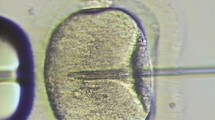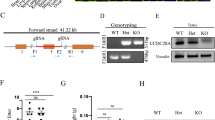Abstract
As one of the transport systems on the sperm plasma membrane, CD4 molecule plays a distinct role in the process of sperm/DNA interaction. This makes it possible to explain the mechanism of sperm-mediated gene transfer (SMGT), which at present is still a mystery in this area. In this study, seminal samples of 60 individuals from seven breed bucks were collected to detect the ability of sperm in internalizing exogenous DNA, and genomic DNA from 147 individual blood samples (including 60 bucks referred ahead) were extracted to test the polymorphisms of CD4 genes by using PCR-SSCP technique. Then the correlation between them was evaluated. The results showed that: (1) it was a novel finding that breed-dependence of exogenous DNA binding to goat spermatozoa. There was the most significant difference among the buck breeds of sperm in binding exogenous DNA (F(6, 53) = 4.811, P = 0.001) and in internalizing them into nuclei (F(6, 53) = 4.587, P = 0.001). The ability of Lezhi Black goat was the lowest (P < 0.01) among the seven breeds. (2) There was no significant correlation between the ability of sperm in internalizing exogenous DNA and each semen quality parameter (P > 0.05). (3) In particular, three single-nucleotide polymorphisms (SNP) were described and there was one SNP (G/A700) of CD4 gene that made G234R substitution in the amino acid sequence of CD4 molecule. Nanjiang Yellow goat and Lezhi Black goat had higher hereditary variation compared with other breeds. (4) CD4 polymorphisms were highly associated with the ability of sperm in internalizing exogenous DNA. The SNP of Caprine CD4 gene exon 6 might be an important molecular marker of the ability to internalize exogenous DNA into sperm.





Similar content being viewed by others
References
Anzar M, Buhr MM (2006) Spontaneous uptake of exogenous DNA by bull spermatozoa. Theriogenology 65:683–690
Ashida ER, Scofield VL (1987) Lymphocyte major histocompatibility complex-encoded class-II structures may act as sperm receptors. Proc Natl Acad Sci USA 84:3395–3399
Bacci ML (2007) A brief overview of transgenic farm animals. Vet Res Commun 31(Suppl 1):9–14
Bandivdekar AH, Velhal SM, Raghavan VP (2003) Identification of CD4-independent HIV receptors on spermatozoa. Am J Reprod Immunol 50:322–327
Boscariol R, Pleasance J, Piedrafita DM, Raadsma HW, Spithill TW (2006) Identification of two allelic forms of ovine CD4 exhibiting a Ser(183)/Pro(183) polymorphism in the coding sequence of domain 3. Vet Immunol Immunopathol 113:305–312. doi:10.1016/j.vetimm.2006.05.015
Brackett B, Boranska W, Sawicki W, Koprowski H (1971) Uptake of heterologous genome by mammalian spermatozoa and its transfer to ova through fertilization. Proc Natl Acad Sci USA 68:353–357
Camaioni A, Russo MA, Odorisio T, Gandolfi F, Fazio VM, Siracusa G (1992) Uptake of exogenous DNA by mammalian spermatozoa—specific localization of DNA on sperm heads. J Reprod Fertil 96:203–212
Du H, Yang J, Zhai X, Sun L, Liu L, Shen W, Min L, Pan Q (2009) Influencing factors of porcine spermatozoa binding and internalization exogenous DNA. Chin J Vet Sci 29:933–938
Gandolfi F (1998) Spermatozoa, DNA binding and transgenic animals. Transgenic Res 7:147–155
Garcia-Vazquez FA, Gutierrez-Adan A, Gadea J (2009) Evaluation of binding sperm-exogenous DNA in ejaculate and epididimary porcine spermatozoa. Archivos De Medicina Veterinaria 41:131–138
Isobe M, Huebner K, Maddon PJ, Littman DR, Axel R, Croce CM (1986) The gene encoding the T-cell surface protein T4 is located on human chromosome-12. Proc Natl Acad Sci USA 83:4399–4402
Lanes CFC, Sampaio LA, Marins LF (2009) Evaluation of DNase activity in seminal plasma and uptake of exogenous DNA by spermatozoa of the Brazilian flounder Paralichthys orbignyanus. Theriogenology 71:525–533. doi:10.1016/j.theriogenology.2008.08.019
Lavitrano M, Camaioni A, Fazio V, Dolci S, Farace M, Spadafora C (1989) Sperm cells as vector for introduction foreign DNA into eggs: genetic transformation of mice. Cell 57:717–723
Lavitrano M, Busnelli M, Cerrito MG, Giovannoni R, Manzini S, Vargiolu A (2006) Sperm-mediated gene transfer. Reprod Fertil Dev 18:19–23
Lavitrano M, Maione B, Forte E, Francolini M, Sperandio S, Testi R, Spadafora C (1997) The interaction of sperm cells with exogenous DNA: a role of CD4 and major histocompatibility complex class II molecules. Exp Cell Res 233:56–62
Lavitrano M, Forni M, Bacci ML, Di Stefano C, Varzi V, Wang H, Seren E (2003) Sperm mediated gene transfer in pig: selection of donor boars and optimization of DNA uptake. Mol Reprod Dev 64:284–291
Lavitrano M, Bacci ML, Forni M, Lazzereschi D, Di Stefano C, Fioretti D, Giancotti P, Marfe G, Pucci L, Renzi L, Wang H, Stoppacciaro A, Stassi G, Sargiacomo M, Sinibaldi P, Turchi V, Giovannoni R, Della Casa G, Seren E, Rossi G (2002) Efficient production by sperm-mediated gene transfer of human decay accelerating factor (hDAF) transgenic pigs for xenotransplantation. Proc Natl Acad Sci USA 99:14230–14235
Lazzereschi D, Forni M, Cappello F, Bacci ML, Di Stefano C, Marfe G, Giancotti P, Renzi L, Wang HJ, Rossi M, Della Casa G, Pretagostini R, Frati G, Bruzzone P, Stassi G, Stoppacciaro A, Turchi V, Cortesini R, Sinibaldi P, Frati L, Lavitrano M (2000) Efficiency of transgenesis using sperm-mediated gene transfer: generation of hDAF transgenic pigs. Transplant Proc 32:892–894
Maione B, Lavitrano M, Spadafora C, Kiessling AA (1998) Sperm-mediated gene transfer in mice. Mol Reprod Dev 50:406–409
Nei M, Roychoud A (1974) Sampling variances of heterozygosity and genetic distance. Genetics 76:379–390
Nei M, Li WH (1979) Mathematical-model for studying genetic-variation in terms of restriction endonucleases. Proc Natl Acad Sci USA 76:5269–5273
Niemann H, Kues WA (2003) Application of transgenesis in livestock for agriculture and biomedicine. Anim Reprod Sci 79:291–317
Sambrook J, Russell D (2001) Molecular cloning: a laboratory manual, 3rd edn. Cold Spring Harbor Laboratory Press, pp 271–275
Shen W, Li L, Pan Q, Min L, Dong H, Deng J (2006) Efficient and simple production of transgenic mice and rabbits using the new DMSO-sperm mediated exogenous DNA transfer method. Mol Reprod Dev 73:589–594
Spadafora C (2007) Sperm-mediated gene transfer: mechanisms and implications. Soc Reprod Fertil Suppl 65:459–467
Sperandio S, Lulli V, Bacci ML, Forni M, Maione B, Spadafora C, Lavitrano M (1996) Sperm-mediated DNA transfer in bovine and swine species. Anim Biotechnol 7:59–77
Weiss N, Hassett M (1984) Introductory Statistics, 3rd edn. Addison-Wesley, Reading, MA, USA
Zhao Y-J, Li F-B, Sun X-M, Zhou J-H, Wei H (2005) Age- and- breed-dependence of exogenous DNA binding to spermatozoa in goats. Acta Zoologica Sinica 51:1058–1066
Zhao Y, Wei H, Wang Y, Wang L, Yu M, Fan J, Zheng S, Zhao C (2010) Production of transgenic goats by sperm-mediated exogenous DNA transfer method. Asian-Aust J Anim Sci 23:33–40
Acknowledgments
The work was supported by: The national natural science foundation of China, grant number: 30600430, National science and technology specific project, grant number: 2008ZX08008-004). We thank Dr. Juan Li (Department of Genetics and Biotechnology, Research Centre Foulum, Aarhus University, DK-8830 Tjele, Denmark) for critical reading of the manuscript, Mr. Hongding Gao (College of Animal Science and Technology, China Agricultural University, Beijing 100094, China) for his help in statistical analysis and the herd owners for their cooperation. We also thank the anonymous reviewers for constructive and professional comments.
Author information
Authors and Affiliations
Corresponding author
Additional information
Lingbin Wang, Jingsheng Fan contributed equally to this work.
Rights and permissions
About this article
Cite this article
Wang, L., Fan, J., Yu, M. et al. Association of goat (Capra hircus) CD4 gene exon 6 polymorphisms with ability of sperm internalizing exogenous DNA. Mol Biol Rep 38, 1621–1628 (2011). https://doi.org/10.1007/s11033-010-0272-2
Received:
Accepted:
Published:
Issue Date:
DOI: https://doi.org/10.1007/s11033-010-0272-2




